Organizational Behaviour: Analysing Key Concepts and Philosophies
VerifiedAdded on 2023/06/06
|15
|4225
|106
Report
AI Summary
This report provides a comprehensive analysis of organisational behaviour within a business context, specifically focusing on Sainsbury's. It explores how an organisation's culture, politics, and power structures influence individual and team behaviour and performance. The report delves into Handy's cultural model (power, task, role, and person cultures) and examines different types of power (legitimate, expert, reward, referent, and coercive) and their impact. Furthermore, it evaluates content and process theories of motivation, including Maslow's hierarchy of needs and Alderfer's ERG theory, to understand how motivational techniques can enable effective goal achievement. The characteristics of effective versus ineffective teams are also discussed, and finally, the report applies organisational behaviour concepts and philosophies within an organisational context, offering insights into improving employee performance and organisational success. The document is available on Desklib, a platform offering study tools for students.
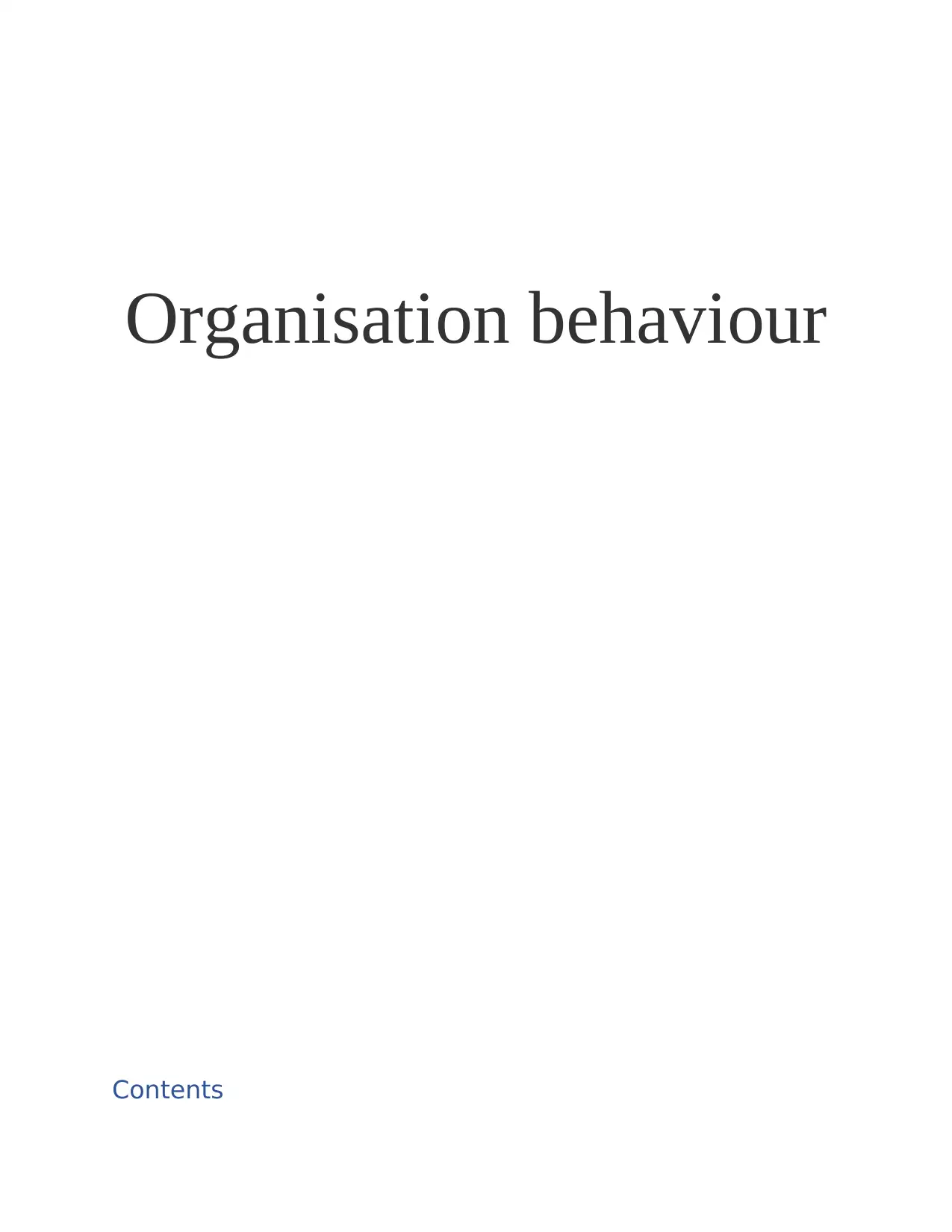
Organisation behaviour
Contents
Contents
Paraphrase This Document
Need a fresh take? Get an instant paraphrase of this document with our AI Paraphraser
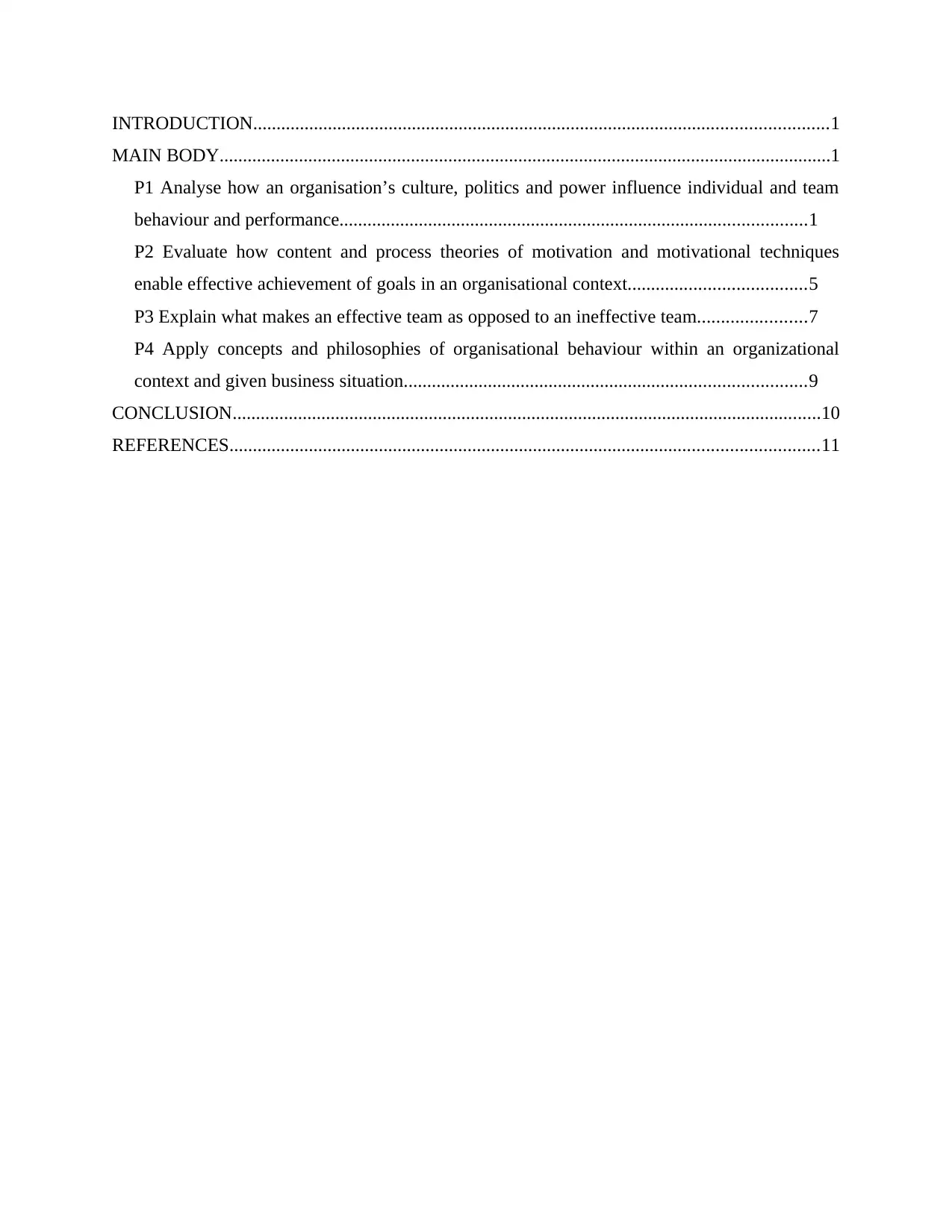
INTRODUCTION...........................................................................................................................1
MAIN BODY...................................................................................................................................1
P1 Analyse how an organisation’s culture, politics and power influence individual and team
behaviour and performance....................................................................................................1
P2 Evaluate how content and process theories of motivation and motivational techniques
enable effective achievement of goals in an organisational context......................................5
P3 Explain what makes an effective team as opposed to an ineffective team.......................7
P4 Apply concepts and philosophies of organisational behaviour within an organizational
context and given business situation......................................................................................9
CONCLUSION..............................................................................................................................10
REFERENCES..............................................................................................................................11
MAIN BODY...................................................................................................................................1
P1 Analyse how an organisation’s culture, politics and power influence individual and team
behaviour and performance....................................................................................................1
P2 Evaluate how content and process theories of motivation and motivational techniques
enable effective achievement of goals in an organisational context......................................5
P3 Explain what makes an effective team as opposed to an ineffective team.......................7
P4 Apply concepts and philosophies of organisational behaviour within an organizational
context and given business situation......................................................................................9
CONCLUSION..............................................................................................................................10
REFERENCES..............................................................................................................................11

⊘ This is a preview!⊘
Do you want full access?
Subscribe today to unlock all pages.

Trusted by 1+ million students worldwide
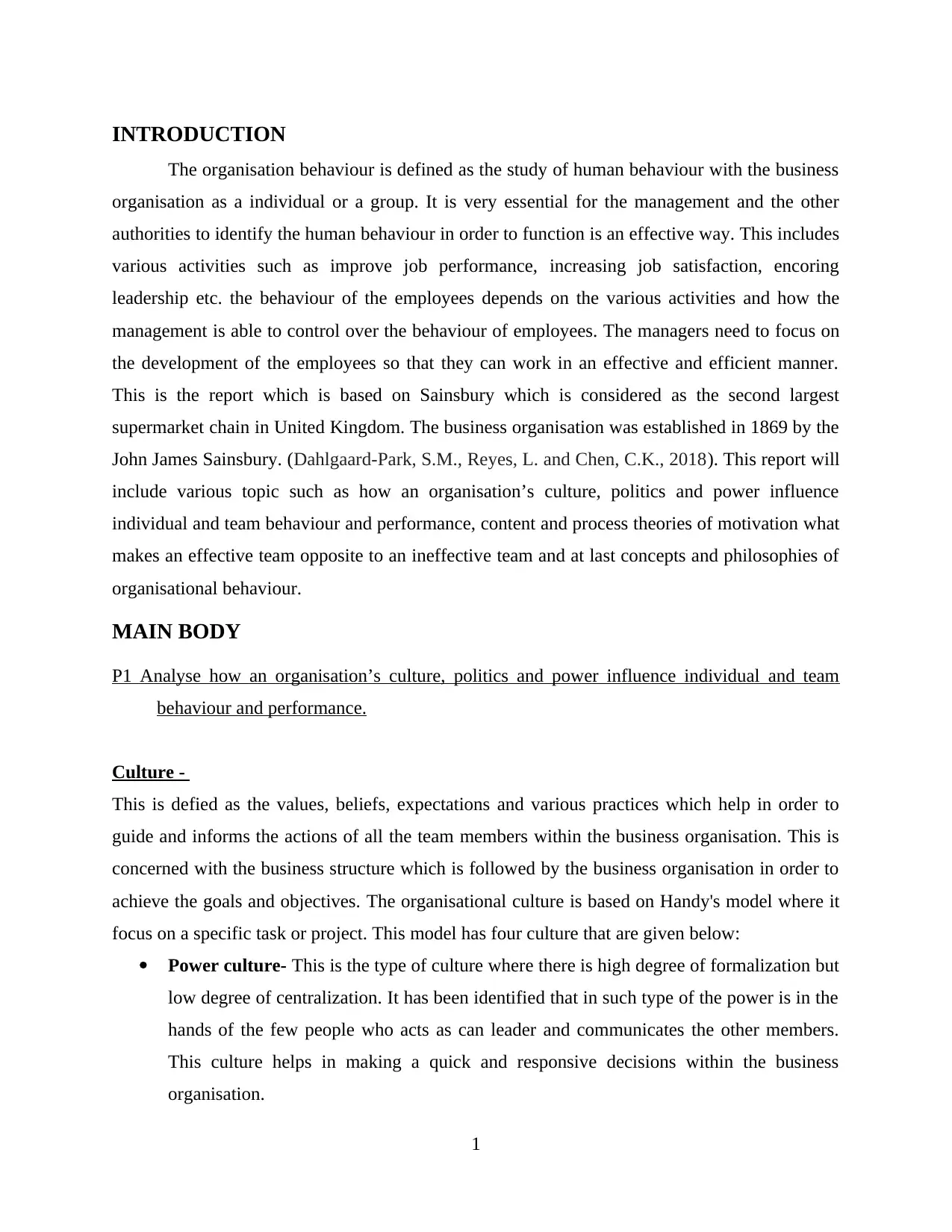
INTRODUCTION
The organisation behaviour is defined as the study of human behaviour with the business
organisation as a individual or a group. It is very essential for the management and the other
authorities to identify the human behaviour in order to function is an effective way. This includes
various activities such as improve job performance, increasing job satisfaction, encoring
leadership etc. the behaviour of the employees depends on the various activities and how the
management is able to control over the behaviour of employees. The managers need to focus on
the development of the employees so that they can work in an effective and efficient manner.
This is the report which is based on Sainsbury which is considered as the second largest
supermarket chain in United Kingdom. The business organisation was established in 1869 by the
John James Sainsbury. (Dahlgaard-Park, S.M., Reyes, L. and Chen, C.K., 2018). This report will
include various topic such as how an organisation’s culture, politics and power influence
individual and team behaviour and performance, content and process theories of motivation what
makes an effective team opposite to an ineffective team and at last concepts and philosophies of
organisational behaviour.
MAIN BODY
P1 Analyse how an organisation’s culture, politics and power influence individual and team
behaviour and performance.
Culture -
This is defied as the values, beliefs, expectations and various practices which help in order to
guide and informs the actions of all the team members within the business organisation. This is
concerned with the business structure which is followed by the business organisation in order to
achieve the goals and objectives. The organisational culture is based on Handy's model where it
focus on a specific task or project. This model has four culture that are given below:
Power culture- This is the type of culture where there is high degree of formalization but
low degree of centralization. It has been identified that in such type of the power is in the
hands of the few people who acts as can leader and communicates the other members.
This culture helps in making a quick and responsive decisions within the business
organisation.
1
The organisation behaviour is defined as the study of human behaviour with the business
organisation as a individual or a group. It is very essential for the management and the other
authorities to identify the human behaviour in order to function is an effective way. This includes
various activities such as improve job performance, increasing job satisfaction, encoring
leadership etc. the behaviour of the employees depends on the various activities and how the
management is able to control over the behaviour of employees. The managers need to focus on
the development of the employees so that they can work in an effective and efficient manner.
This is the report which is based on Sainsbury which is considered as the second largest
supermarket chain in United Kingdom. The business organisation was established in 1869 by the
John James Sainsbury. (Dahlgaard-Park, S.M., Reyes, L. and Chen, C.K., 2018). This report will
include various topic such as how an organisation’s culture, politics and power influence
individual and team behaviour and performance, content and process theories of motivation what
makes an effective team opposite to an ineffective team and at last concepts and philosophies of
organisational behaviour.
MAIN BODY
P1 Analyse how an organisation’s culture, politics and power influence individual and team
behaviour and performance.
Culture -
This is defied as the values, beliefs, expectations and various practices which help in order to
guide and informs the actions of all the team members within the business organisation. This is
concerned with the business structure which is followed by the business organisation in order to
achieve the goals and objectives. The organisational culture is based on Handy's model where it
focus on a specific task or project. This model has four culture that are given below:
Power culture- This is the type of culture where there is high degree of formalization but
low degree of centralization. It has been identified that in such type of the power is in the
hands of the few people who acts as can leader and communicates the other members.
This culture helps in making a quick and responsive decisions within the business
organisation.
1
Paraphrase This Document
Need a fresh take? Get an instant paraphrase of this document with our AI Paraphraser
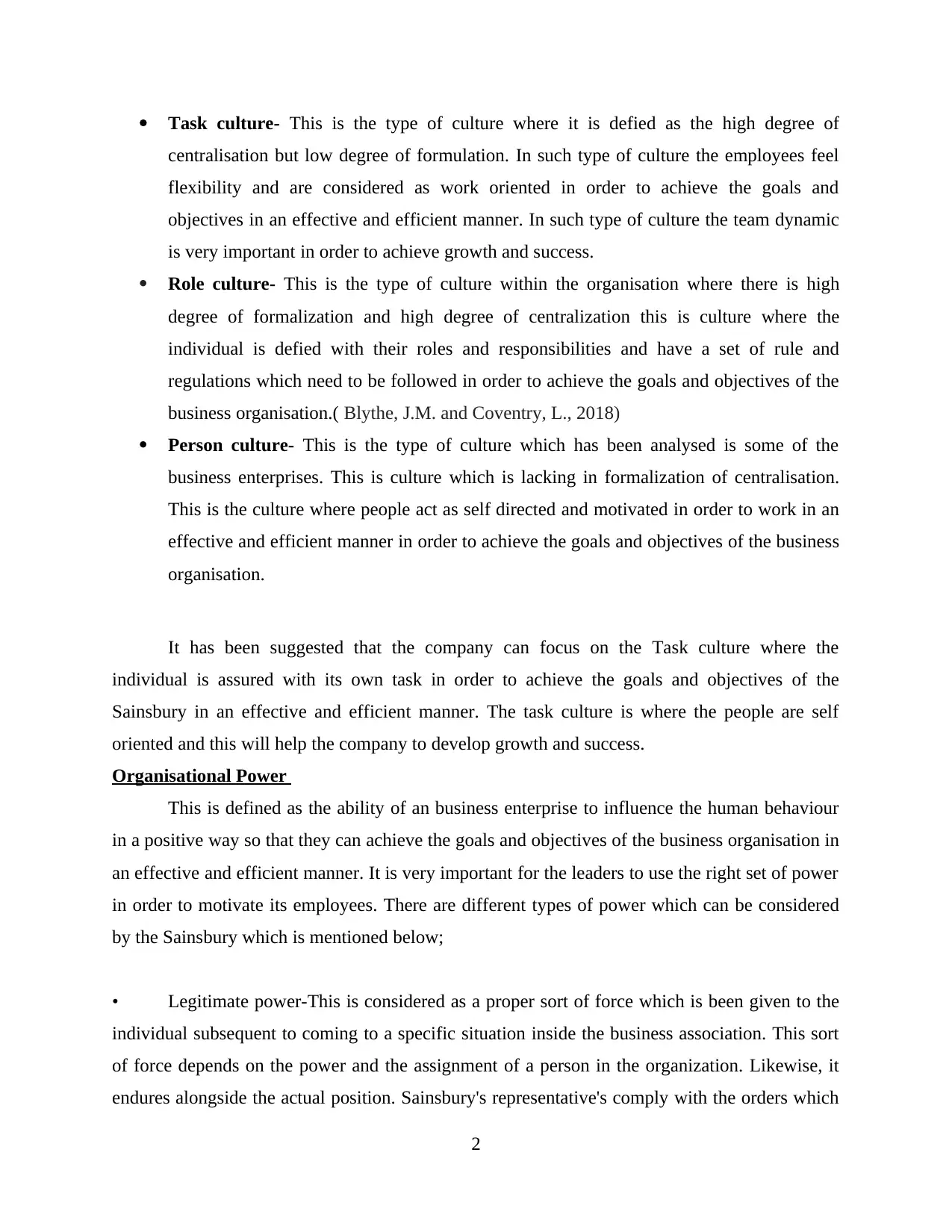
Task culture- This is the type of culture where it is defied as the high degree of
centralisation but low degree of formulation. In such type of culture the employees feel
flexibility and are considered as work oriented in order to achieve the goals and
objectives in an effective and efficient manner. In such type of culture the team dynamic
is very important in order to achieve growth and success.
Role culture- This is the type of culture within the organisation where there is high
degree of formalization and high degree of centralization this is culture where the
individual is defied with their roles and responsibilities and have a set of rule and
regulations which need to be followed in order to achieve the goals and objectives of the
business organisation.( Blythe, J.M. and Coventry, L., 2018)
Person culture- This is the type of culture which has been analysed is some of the
business enterprises. This is culture which is lacking in formalization of centralisation.
This is the culture where people act as self directed and motivated in order to work in an
effective and efficient manner in order to achieve the goals and objectives of the business
organisation.
It has been suggested that the company can focus on the Task culture where the
individual is assured with its own task in order to achieve the goals and objectives of the
Sainsbury in an effective and efficient manner. The task culture is where the people are self
oriented and this will help the company to develop growth and success.
Organisational Power
This is defined as the ability of an business enterprise to influence the human behaviour
in a positive way so that they can achieve the goals and objectives of the business organisation in
an effective and efficient manner. It is very important for the leaders to use the right set of power
in order to motivate its employees. There are different types of power which can be considered
by the Sainsbury which is mentioned below;
• Legitimate power-This is considered as a proper sort of force which is been given to the
individual subsequent to coming to a specific situation inside the business association. This sort
of force depends on the power and the assignment of a person in the organization. Likewise, it
endures alongside the actual position. Sainsbury's representative's comply with the orders which
2
centralisation but low degree of formulation. In such type of culture the employees feel
flexibility and are considered as work oriented in order to achieve the goals and
objectives in an effective and efficient manner. In such type of culture the team dynamic
is very important in order to achieve growth and success.
Role culture- This is the type of culture within the organisation where there is high
degree of formalization and high degree of centralization this is culture where the
individual is defied with their roles and responsibilities and have a set of rule and
regulations which need to be followed in order to achieve the goals and objectives of the
business organisation.( Blythe, J.M. and Coventry, L., 2018)
Person culture- This is the type of culture which has been analysed is some of the
business enterprises. This is culture which is lacking in formalization of centralisation.
This is the culture where people act as self directed and motivated in order to work in an
effective and efficient manner in order to achieve the goals and objectives of the business
organisation.
It has been suggested that the company can focus on the Task culture where the
individual is assured with its own task in order to achieve the goals and objectives of the
Sainsbury in an effective and efficient manner. The task culture is where the people are self
oriented and this will help the company to develop growth and success.
Organisational Power
This is defined as the ability of an business enterprise to influence the human behaviour
in a positive way so that they can achieve the goals and objectives of the business organisation in
an effective and efficient manner. It is very important for the leaders to use the right set of power
in order to motivate its employees. There are different types of power which can be considered
by the Sainsbury which is mentioned below;
• Legitimate power-This is considered as a proper sort of force which is been given to the
individual subsequent to coming to a specific situation inside the business association. This sort
of force depends on the power and the assignment of a person in the organization. Likewise, it
endures alongside the actual position. Sainsbury's representative's comply with the orders which
2
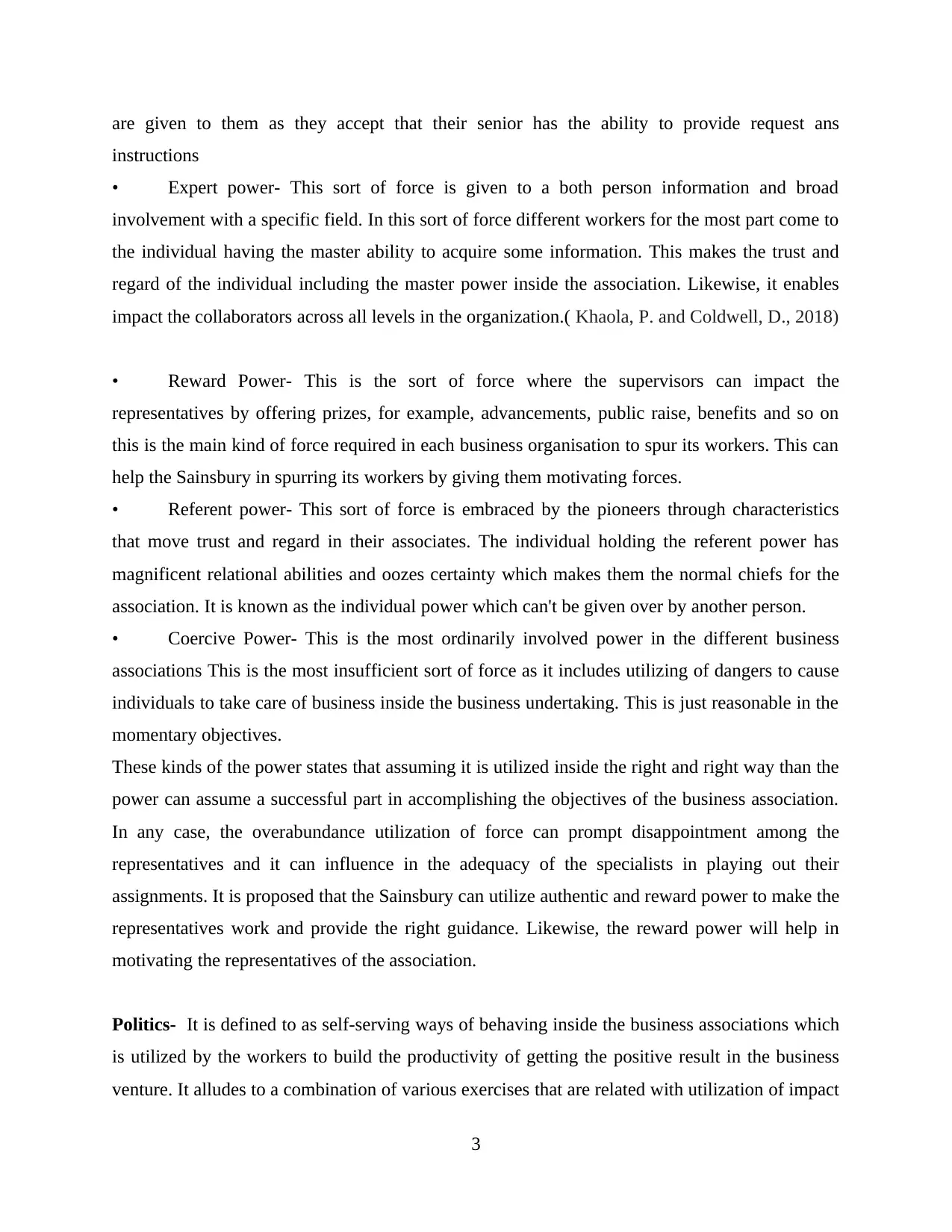
are given to them as they accept that their senior has the ability to provide request ans
instructions
• Expert power- This sort of force is given to a both person information and broad
involvement with a specific field. In this sort of force different workers for the most part come to
the individual having the master ability to acquire some information. This makes the trust and
regard of the individual including the master power inside the association. Likewise, it enables
impact the collaborators across all levels in the organization.( Khaola, P. and Coldwell, D., 2018)
• Reward Power- This is the sort of force where the supervisors can impact the
representatives by offering prizes, for example, advancements, public raise, benefits and so on
this is the main kind of force required in each business organisation to spur its workers. This can
help the Sainsbury in spurring its workers by giving them motivating forces.
• Referent power- This sort of force is embraced by the pioneers through characteristics
that move trust and regard in their associates. The individual holding the referent power has
magnificent relational abilities and oozes certainty which makes them the normal chiefs for the
association. It is known as the individual power which can't be given over by another person.
• Coercive Power- This is the most ordinarily involved power in the different business
associations This is the most insufficient sort of force as it includes utilizing of dangers to cause
individuals to take care of business inside the business undertaking. This is just reasonable in the
momentary objectives.
These kinds of the power states that assuming it is utilized inside the right and right way than the
power can assume a successful part in accomplishing the objectives of the business association.
In any case, the overabundance utilization of force can prompt disappointment among the
representatives and it can influence in the adequacy of the specialists in playing out their
assignments. It is proposed that the Sainsbury can utilize authentic and reward power to make the
representatives work and provide the right guidance. Likewise, the reward power will help in
motivating the representatives of the association.
Politics- It is defined to as self-serving ways of behaving inside the business associations which
is utilized by the workers to build the productivity of getting the positive result in the business
venture. It alludes to a combination of various exercises that are related with utilization of impact
3
instructions
• Expert power- This sort of force is given to a both person information and broad
involvement with a specific field. In this sort of force different workers for the most part come to
the individual having the master ability to acquire some information. This makes the trust and
regard of the individual including the master power inside the association. Likewise, it enables
impact the collaborators across all levels in the organization.( Khaola, P. and Coldwell, D., 2018)
• Reward Power- This is the sort of force where the supervisors can impact the
representatives by offering prizes, for example, advancements, public raise, benefits and so on
this is the main kind of force required in each business organisation to spur its workers. This can
help the Sainsbury in spurring its workers by giving them motivating forces.
• Referent power- This sort of force is embraced by the pioneers through characteristics
that move trust and regard in their associates. The individual holding the referent power has
magnificent relational abilities and oozes certainty which makes them the normal chiefs for the
association. It is known as the individual power which can't be given over by another person.
• Coercive Power- This is the most ordinarily involved power in the different business
associations This is the most insufficient sort of force as it includes utilizing of dangers to cause
individuals to take care of business inside the business undertaking. This is just reasonable in the
momentary objectives.
These kinds of the power states that assuming it is utilized inside the right and right way than the
power can assume a successful part in accomplishing the objectives of the business association.
In any case, the overabundance utilization of force can prompt disappointment among the
representatives and it can influence in the adequacy of the specialists in playing out their
assignments. It is proposed that the Sainsbury can utilize authentic and reward power to make the
representatives work and provide the right guidance. Likewise, the reward power will help in
motivating the representatives of the association.
Politics- It is defined to as self-serving ways of behaving inside the business associations which
is utilized by the workers to build the productivity of getting the positive result in the business
venture. It alludes to a combination of various exercises that are related with utilization of impact
3
⊘ This is a preview!⊘
Do you want full access?
Subscribe today to unlock all pages.

Trusted by 1+ million students worldwide
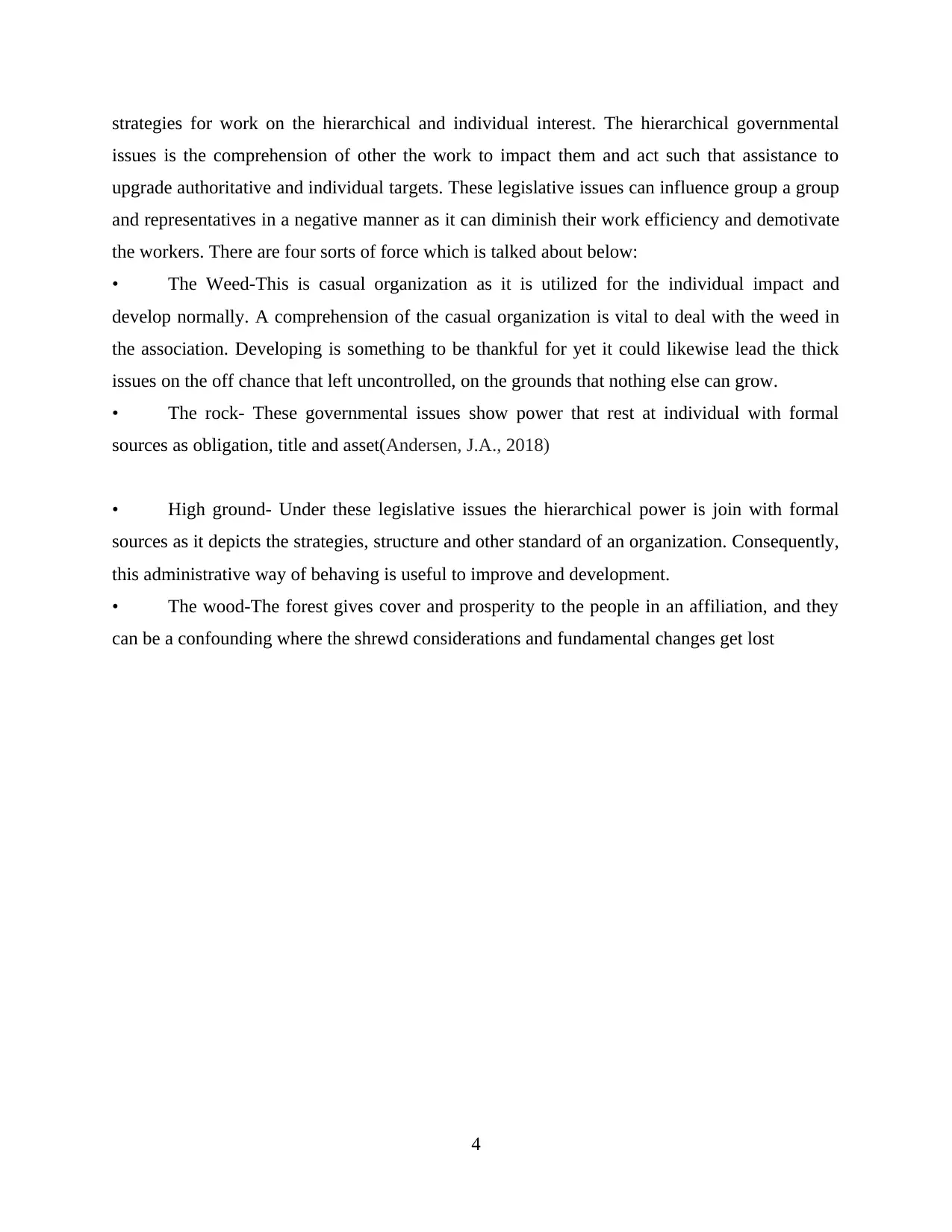
strategies for work on the hierarchical and individual interest. The hierarchical governmental
issues is the comprehension of other the work to impact them and act such that assistance to
upgrade authoritative and individual targets. These legislative issues can influence group a group
and representatives in a negative manner as it can diminish their work efficiency and demotivate
the workers. There are four sorts of force which is talked about below:
• The Weed-This is casual organization as it is utilized for the individual impact and
develop normally. A comprehension of the casual organization is vital to deal with the weed in
the association. Developing is something to be thankful for yet it could likewise lead the thick
issues on the off chance that left uncontrolled, on the grounds that nothing else can grow.
• The rock- These governmental issues show power that rest at individual with formal
sources as obligation, title and asset(Andersen, J.A., 2018)
• High ground- Under these legislative issues the hierarchical power is join with formal
sources as it depicts the strategies, structure and other standard of an organization. Consequently,
this administrative way of behaving is useful to improve and development.
• The wood-The forest gives cover and prosperity to the people in an affiliation, and they
can be a confounding where the shrewd considerations and fundamental changes get lost
4
issues is the comprehension of other the work to impact them and act such that assistance to
upgrade authoritative and individual targets. These legislative issues can influence group a group
and representatives in a negative manner as it can diminish their work efficiency and demotivate
the workers. There are four sorts of force which is talked about below:
• The Weed-This is casual organization as it is utilized for the individual impact and
develop normally. A comprehension of the casual organization is vital to deal with the weed in
the association. Developing is something to be thankful for yet it could likewise lead the thick
issues on the off chance that left uncontrolled, on the grounds that nothing else can grow.
• The rock- These governmental issues show power that rest at individual with formal
sources as obligation, title and asset(Andersen, J.A., 2018)
• High ground- Under these legislative issues the hierarchical power is join with formal
sources as it depicts the strategies, structure and other standard of an organization. Consequently,
this administrative way of behaving is useful to improve and development.
• The wood-The forest gives cover and prosperity to the people in an affiliation, and they
can be a confounding where the shrewd considerations and fundamental changes get lost
4
Paraphrase This Document
Need a fresh take? Get an instant paraphrase of this document with our AI Paraphraser
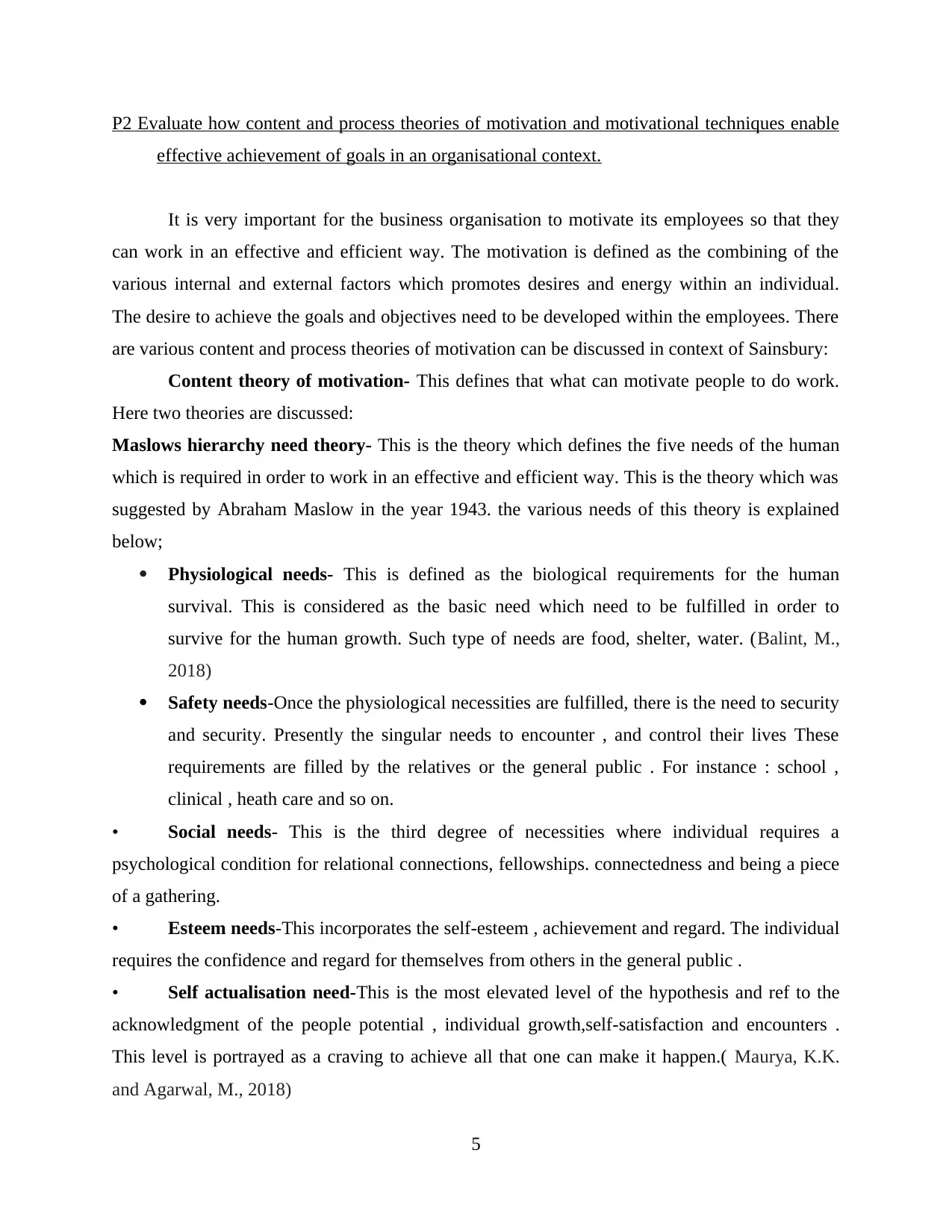
P2 Evaluate how content and process theories of motivation and motivational techniques enable
effective achievement of goals in an organisational context.
It is very important for the business organisation to motivate its employees so that they
can work in an effective and efficient way. The motivation is defined as the combining of the
various internal and external factors which promotes desires and energy within an individual.
The desire to achieve the goals and objectives need to be developed within the employees. There
are various content and process theories of motivation can be discussed in context of Sainsbury:
Content theory of motivation- This defines that what can motivate people to do work.
Here two theories are discussed:
Maslows hierarchy need theory- This is the theory which defines the five needs of the human
which is required in order to work in an effective and efficient way. This is the theory which was
suggested by Abraham Maslow in the year 1943. the various needs of this theory is explained
below;
Physiological needs- This is defined as the biological requirements for the human
survival. This is considered as the basic need which need to be fulfilled in order to
survive for the human growth. Such type of needs are food, shelter, water. (Balint, M.,
2018)
Safety needs-Once the physiological necessities are fulfilled, there is the need to security
and security. Presently the singular needs to encounter , and control their lives These
requirements are filled by the relatives or the general public . For instance : school ,
clinical , heath care and so on.
• Social needs- This is the third degree of necessities where individual requires a
psychological condition for relational connections, fellowships. connectedness and being a piece
of a gathering.
• Esteem needs-This incorporates the self-esteem , achievement and regard. The individual
requires the confidence and regard for themselves from others in the general public .
• Self actualisation need-This is the most elevated level of the hypothesis and ref to the
acknowledgment of the people potential , individual growth,self-satisfaction and encounters .
This level is portrayed as a craving to achieve all that one can make it happen.( Maurya, K.K.
and Agarwal, M., 2018)
5
effective achievement of goals in an organisational context.
It is very important for the business organisation to motivate its employees so that they
can work in an effective and efficient way. The motivation is defined as the combining of the
various internal and external factors which promotes desires and energy within an individual.
The desire to achieve the goals and objectives need to be developed within the employees. There
are various content and process theories of motivation can be discussed in context of Sainsbury:
Content theory of motivation- This defines that what can motivate people to do work.
Here two theories are discussed:
Maslows hierarchy need theory- This is the theory which defines the five needs of the human
which is required in order to work in an effective and efficient way. This is the theory which was
suggested by Abraham Maslow in the year 1943. the various needs of this theory is explained
below;
Physiological needs- This is defined as the biological requirements for the human
survival. This is considered as the basic need which need to be fulfilled in order to
survive for the human growth. Such type of needs are food, shelter, water. (Balint, M.,
2018)
Safety needs-Once the physiological necessities are fulfilled, there is the need to security
and security. Presently the singular needs to encounter , and control their lives These
requirements are filled by the relatives or the general public . For instance : school ,
clinical , heath care and so on.
• Social needs- This is the third degree of necessities where individual requires a
psychological condition for relational connections, fellowships. connectedness and being a piece
of a gathering.
• Esteem needs-This incorporates the self-esteem , achievement and regard. The individual
requires the confidence and regard for themselves from others in the general public .
• Self actualisation need-This is the most elevated level of the hypothesis and ref to the
acknowledgment of the people potential , individual growth,self-satisfaction and encounters .
This level is portrayed as a craving to achieve all that one can make it happen.( Maurya, K.K.
and Agarwal, M., 2018)
5
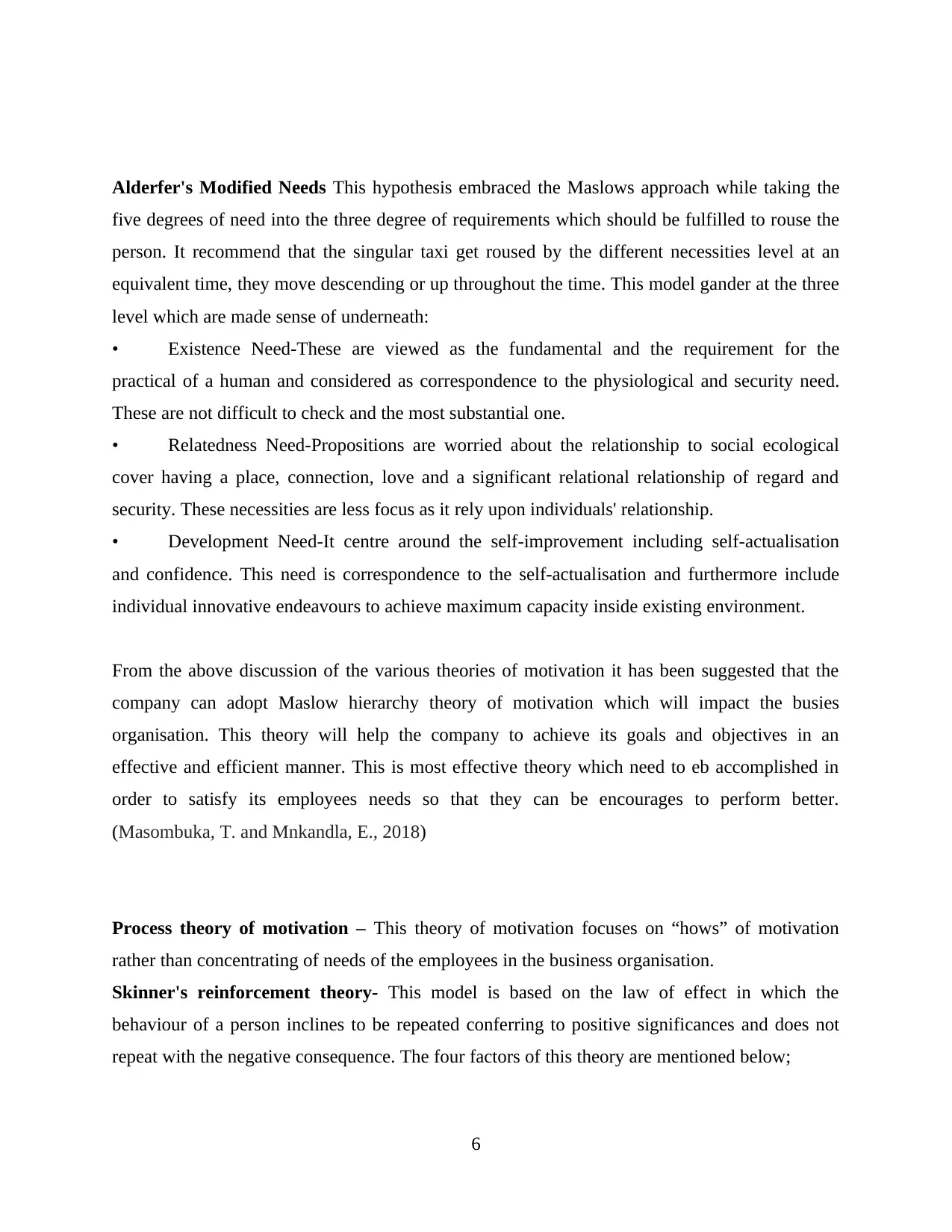
Alderfer's Modified Needs This hypothesis embraced the Maslows approach while taking the
five degrees of need into the three degree of requirements which should be fulfilled to rouse the
person. It recommend that the singular taxi get roused by the different necessities level at an
equivalent time, they move descending or up throughout the time. This model gander at the three
level which are made sense of underneath:
• Existence Need-These are viewed as the fundamental and the requirement for the
practical of a human and considered as correspondence to the physiological and security need.
These are not difficult to check and the most substantial one.
• Relatedness Need-Propositions are worried about the relationship to social ecological
cover having a place, connection, love and a significant relational relationship of regard and
security. These necessities are less focus as it rely upon individuals' relationship.
• Development Need-It centre around the self-improvement including self-actualisation
and confidence. This need is correspondence to the self-actualisation and furthermore include
individual innovative endeavours to achieve maximum capacity inside existing environment.
From the above discussion of the various theories of motivation it has been suggested that the
company can adopt Maslow hierarchy theory of motivation which will impact the busies
organisation. This theory will help the company to achieve its goals and objectives in an
effective and efficient manner. This is most effective theory which need to eb accomplished in
order to satisfy its employees needs so that they can be encourages to perform better.
(Masombuka, T. and Mnkandla, E., 2018)
Process theory of motivation – This theory of motivation focuses on “hows” of motivation
rather than concentrating of needs of the employees in the business organisation.
Skinner's reinforcement theory- This model is based on the law of effect in which the
behaviour of a person inclines to be repeated conferring to positive significances and does not
repeat with the negative consequence. The four factors of this theory are mentioned below;
6
five degrees of need into the three degree of requirements which should be fulfilled to rouse the
person. It recommend that the singular taxi get roused by the different necessities level at an
equivalent time, they move descending or up throughout the time. This model gander at the three
level which are made sense of underneath:
• Existence Need-These are viewed as the fundamental and the requirement for the
practical of a human and considered as correspondence to the physiological and security need.
These are not difficult to check and the most substantial one.
• Relatedness Need-Propositions are worried about the relationship to social ecological
cover having a place, connection, love and a significant relational relationship of regard and
security. These necessities are less focus as it rely upon individuals' relationship.
• Development Need-It centre around the self-improvement including self-actualisation
and confidence. This need is correspondence to the self-actualisation and furthermore include
individual innovative endeavours to achieve maximum capacity inside existing environment.
From the above discussion of the various theories of motivation it has been suggested that the
company can adopt Maslow hierarchy theory of motivation which will impact the busies
organisation. This theory will help the company to achieve its goals and objectives in an
effective and efficient manner. This is most effective theory which need to eb accomplished in
order to satisfy its employees needs so that they can be encourages to perform better.
(Masombuka, T. and Mnkandla, E., 2018)
Process theory of motivation – This theory of motivation focuses on “hows” of motivation
rather than concentrating of needs of the employees in the business organisation.
Skinner's reinforcement theory- This model is based on the law of effect in which the
behaviour of a person inclines to be repeated conferring to positive significances and does not
repeat with the negative consequence. The four factors of this theory are mentioned below;
6
⊘ This is a preview!⊘
Do you want full access?
Subscribe today to unlock all pages.

Trusted by 1+ million students worldwide
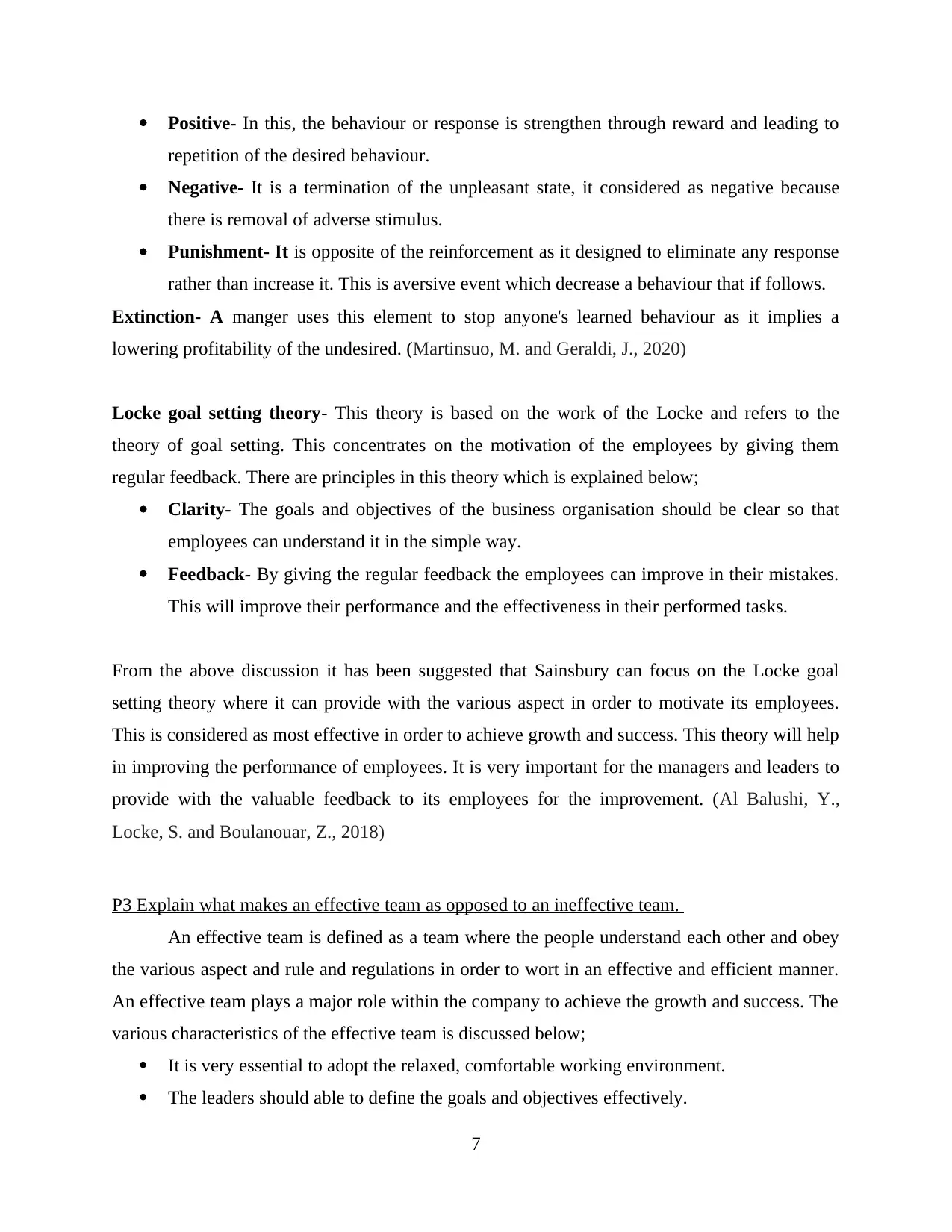
Positive- In this, the behaviour or response is strengthen through reward and leading to
repetition of the desired behaviour.
Negative- It is a termination of the unpleasant state, it considered as negative because
there is removal of adverse stimulus.
Punishment- It is opposite of the reinforcement as it designed to eliminate any response
rather than increase it. This is aversive event which decrease a behaviour that if follows.
Extinction- A manger uses this element to stop anyone's learned behaviour as it implies a
lowering profitability of the undesired. (Martinsuo, M. and Geraldi, J., 2020)
Locke goal setting theory- This theory is based on the work of the Locke and refers to the
theory of goal setting. This concentrates on the motivation of the employees by giving them
regular feedback. There are principles in this theory which is explained below;
Clarity- The goals and objectives of the business organisation should be clear so that
employees can understand it in the simple way.
Feedback- By giving the regular feedback the employees can improve in their mistakes.
This will improve their performance and the effectiveness in their performed tasks.
From the above discussion it has been suggested that Sainsbury can focus on the Locke goal
setting theory where it can provide with the various aspect in order to motivate its employees.
This is considered as most effective in order to achieve growth and success. This theory will help
in improving the performance of employees. It is very important for the managers and leaders to
provide with the valuable feedback to its employees for the improvement. (Al Balushi, Y.,
Locke, S. and Boulanouar, Z., 2018)
P3 Explain what makes an effective team as opposed to an ineffective team.
An effective team is defined as a team where the people understand each other and obey
the various aspect and rule and regulations in order to wort in an effective and efficient manner.
An effective team plays a major role within the company to achieve the growth and success. The
various characteristics of the effective team is discussed below;
It is very essential to adopt the relaxed, comfortable working environment.
The leaders should able to define the goals and objectives effectively.
7
repetition of the desired behaviour.
Negative- It is a termination of the unpleasant state, it considered as negative because
there is removal of adverse stimulus.
Punishment- It is opposite of the reinforcement as it designed to eliminate any response
rather than increase it. This is aversive event which decrease a behaviour that if follows.
Extinction- A manger uses this element to stop anyone's learned behaviour as it implies a
lowering profitability of the undesired. (Martinsuo, M. and Geraldi, J., 2020)
Locke goal setting theory- This theory is based on the work of the Locke and refers to the
theory of goal setting. This concentrates on the motivation of the employees by giving them
regular feedback. There are principles in this theory which is explained below;
Clarity- The goals and objectives of the business organisation should be clear so that
employees can understand it in the simple way.
Feedback- By giving the regular feedback the employees can improve in their mistakes.
This will improve their performance and the effectiveness in their performed tasks.
From the above discussion it has been suggested that Sainsbury can focus on the Locke goal
setting theory where it can provide with the various aspect in order to motivate its employees.
This is considered as most effective in order to achieve growth and success. This theory will help
in improving the performance of employees. It is very important for the managers and leaders to
provide with the valuable feedback to its employees for the improvement. (Al Balushi, Y.,
Locke, S. and Boulanouar, Z., 2018)
P3 Explain what makes an effective team as opposed to an ineffective team.
An effective team is defined as a team where the people understand each other and obey
the various aspect and rule and regulations in order to wort in an effective and efficient manner.
An effective team plays a major role within the company to achieve the growth and success. The
various characteristics of the effective team is discussed below;
It is very essential to adopt the relaxed, comfortable working environment.
The leaders should able to define the goals and objectives effectively.
7
Paraphrase This Document
Need a fresh take? Get an instant paraphrase of this document with our AI Paraphraser
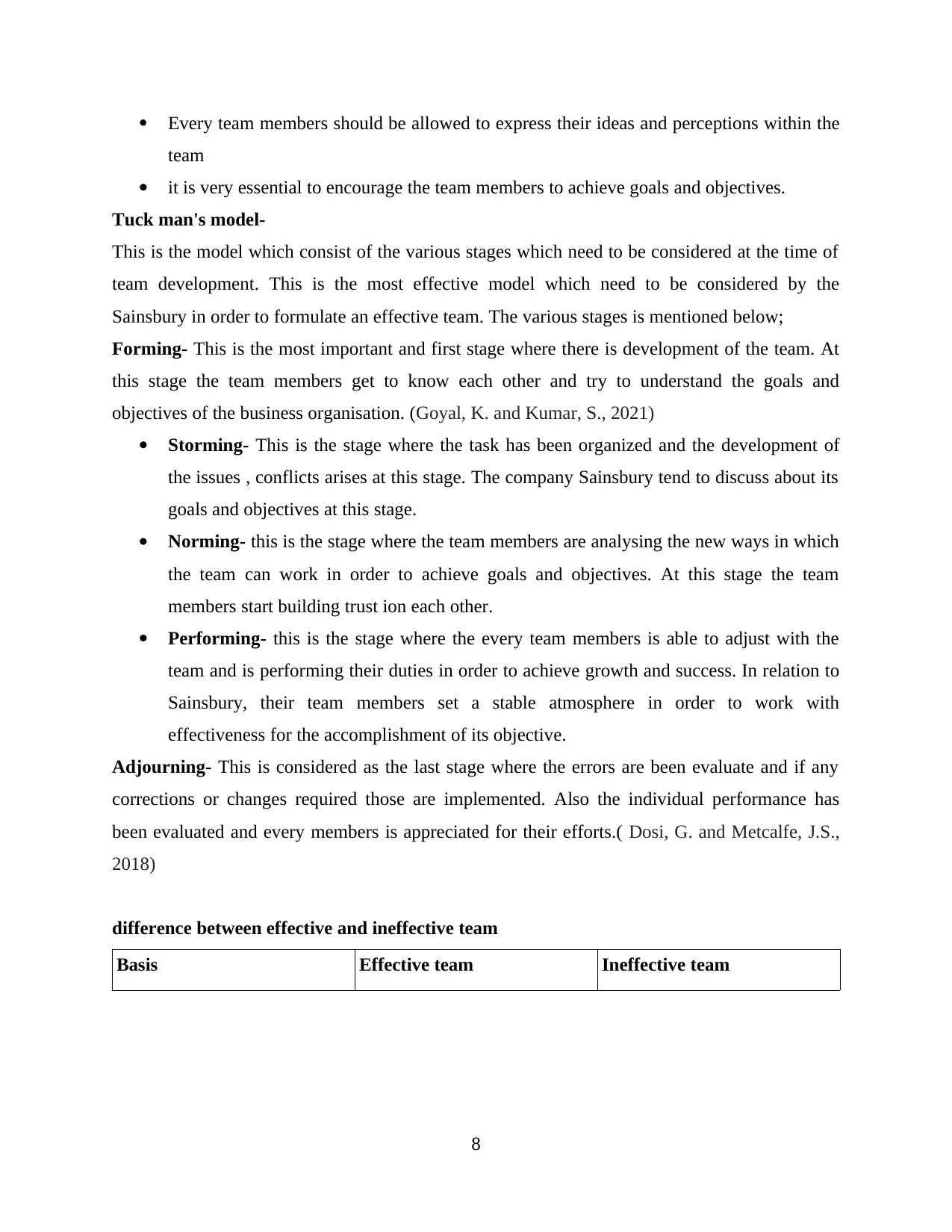
Every team members should be allowed to express their ideas and perceptions within the
team
it is very essential to encourage the team members to achieve goals and objectives.
Tuck man's model-
This is the model which consist of the various stages which need to be considered at the time of
team development. This is the most effective model which need to be considered by the
Sainsbury in order to formulate an effective team. The various stages is mentioned below;
Forming- This is the most important and first stage where there is development of the team. At
this stage the team members get to know each other and try to understand the goals and
objectives of the business organisation. (Goyal, K. and Kumar, S., 2021)
Storming- This is the stage where the task has been organized and the development of
the issues , conflicts arises at this stage. The company Sainsbury tend to discuss about its
goals and objectives at this stage.
Norming- this is the stage where the team members are analysing the new ways in which
the team can work in order to achieve goals and objectives. At this stage the team
members start building trust ion each other.
Performing- this is the stage where the every team members is able to adjust with the
team and is performing their duties in order to achieve growth and success. In relation to
Sainsbury, their team members set a stable atmosphere in order to work with
effectiveness for the accomplishment of its objective.
Adjourning- This is considered as the last stage where the errors are been evaluate and if any
corrections or changes required those are implemented. Also the individual performance has
been evaluated and every members is appreciated for their efforts.( Dosi, G. and Metcalfe, J.S.,
2018)
difference between effective and ineffective team
Basis Effective team Ineffective team
8
team
it is very essential to encourage the team members to achieve goals and objectives.
Tuck man's model-
This is the model which consist of the various stages which need to be considered at the time of
team development. This is the most effective model which need to be considered by the
Sainsbury in order to formulate an effective team. The various stages is mentioned below;
Forming- This is the most important and first stage where there is development of the team. At
this stage the team members get to know each other and try to understand the goals and
objectives of the business organisation. (Goyal, K. and Kumar, S., 2021)
Storming- This is the stage where the task has been organized and the development of
the issues , conflicts arises at this stage. The company Sainsbury tend to discuss about its
goals and objectives at this stage.
Norming- this is the stage where the team members are analysing the new ways in which
the team can work in order to achieve goals and objectives. At this stage the team
members start building trust ion each other.
Performing- this is the stage where the every team members is able to adjust with the
team and is performing their duties in order to achieve growth and success. In relation to
Sainsbury, their team members set a stable atmosphere in order to work with
effectiveness for the accomplishment of its objective.
Adjourning- This is considered as the last stage where the errors are been evaluate and if any
corrections or changes required those are implemented. Also the individual performance has
been evaluated and every members is appreciated for their efforts.( Dosi, G. and Metcalfe, J.S.,
2018)
difference between effective and ineffective team
Basis Effective team Ineffective team
8
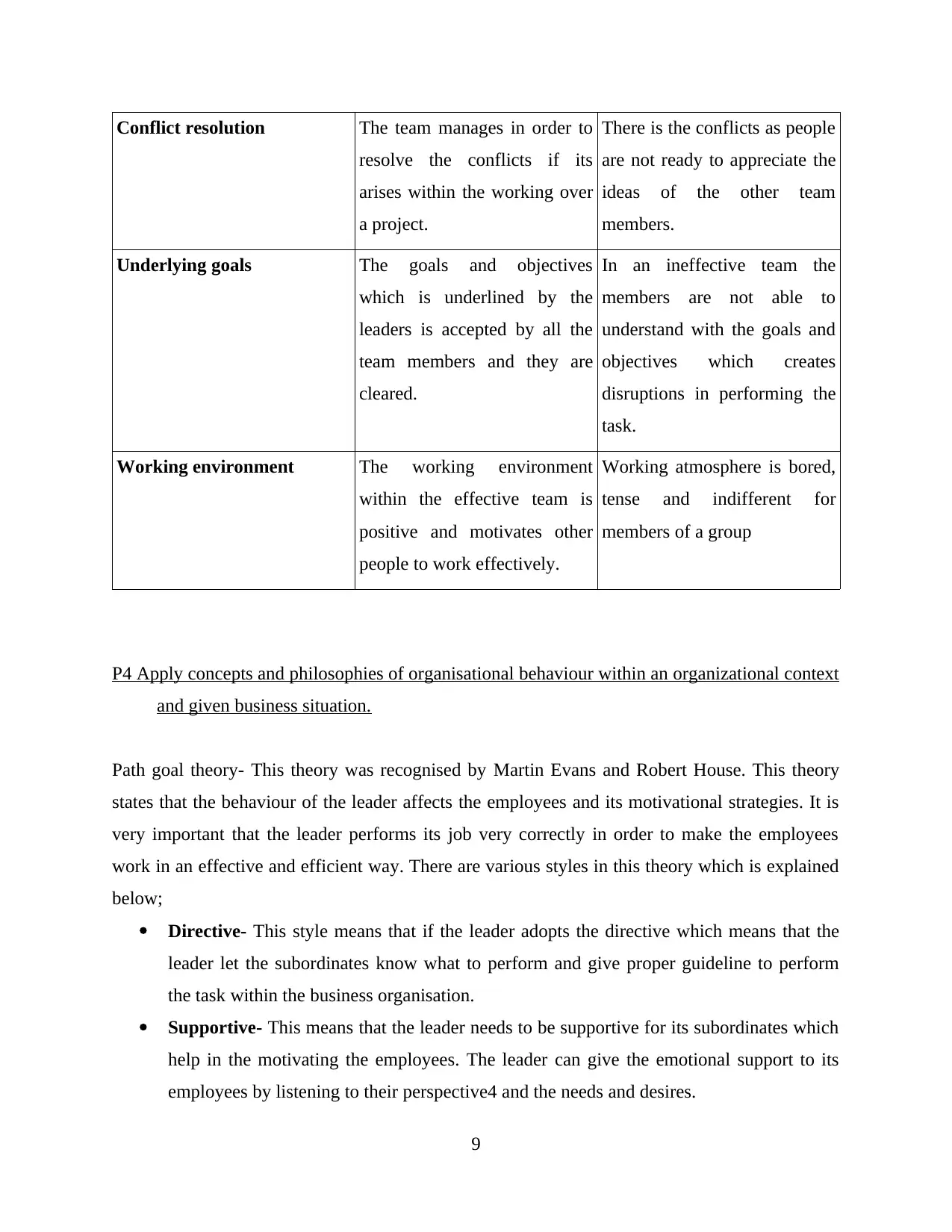
Conflict resolution The team manages in order to
resolve the conflicts if its
arises within the working over
a project.
There is the conflicts as people
are not ready to appreciate the
ideas of the other team
members.
Underlying goals The goals and objectives
which is underlined by the
leaders is accepted by all the
team members and they are
cleared.
In an ineffective team the
members are not able to
understand with the goals and
objectives which creates
disruptions in performing the
task.
Working environment The working environment
within the effective team is
positive and motivates other
people to work effectively.
Working atmosphere is bored,
tense and indifferent for
members of a group
P4 Apply concepts and philosophies of organisational behaviour within an organizational context
and given business situation.
Path goal theory- This theory was recognised by Martin Evans and Robert House. This theory
states that the behaviour of the leader affects the employees and its motivational strategies. It is
very important that the leader performs its job very correctly in order to make the employees
work in an effective and efficient way. There are various styles in this theory which is explained
below;
Directive- This style means that if the leader adopts the directive which means that the
leader let the subordinates know what to perform and give proper guideline to perform
the task within the business organisation.
Supportive- This means that the leader needs to be supportive for its subordinates which
help in the motivating the employees. The leader can give the emotional support to its
employees by listening to their perspective4 and the needs and desires.
9
resolve the conflicts if its
arises within the working over
a project.
There is the conflicts as people
are not ready to appreciate the
ideas of the other team
members.
Underlying goals The goals and objectives
which is underlined by the
leaders is accepted by all the
team members and they are
cleared.
In an ineffective team the
members are not able to
understand with the goals and
objectives which creates
disruptions in performing the
task.
Working environment The working environment
within the effective team is
positive and motivates other
people to work effectively.
Working atmosphere is bored,
tense and indifferent for
members of a group
P4 Apply concepts and philosophies of organisational behaviour within an organizational context
and given business situation.
Path goal theory- This theory was recognised by Martin Evans and Robert House. This theory
states that the behaviour of the leader affects the employees and its motivational strategies. It is
very important that the leader performs its job very correctly in order to make the employees
work in an effective and efficient way. There are various styles in this theory which is explained
below;
Directive- This style means that if the leader adopts the directive which means that the
leader let the subordinates know what to perform and give proper guideline to perform
the task within the business organisation.
Supportive- This means that the leader needs to be supportive for its subordinates which
help in the motivating the employees. The leader can give the emotional support to its
employees by listening to their perspective4 and the needs and desires.
9
⊘ This is a preview!⊘
Do you want full access?
Subscribe today to unlock all pages.

Trusted by 1+ million students worldwide
1 out of 15
Related Documents
Your All-in-One AI-Powered Toolkit for Academic Success.
+13062052269
info@desklib.com
Available 24*7 on WhatsApp / Email
![[object Object]](/_next/static/media/star-bottom.7253800d.svg)
Unlock your academic potential
Copyright © 2020–2025 A2Z Services. All Rights Reserved. Developed and managed by ZUCOL.




